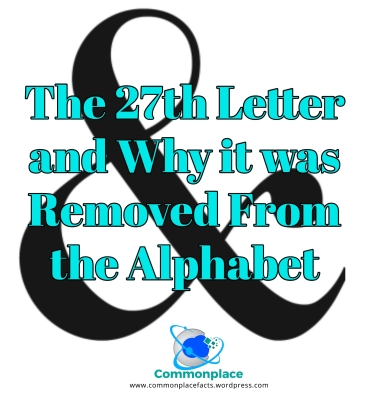
Every schoolchild knows there are 26 letters in the English alphabet. It seems self-evident that this fact must be as old as the language itself. Surprising as it may seem, as recently as the mid-1800s, there was a 27th letter — one you see on your computer keyboard every day, without suspecting that it once held equal status with A, B, C, and all of their comrades.
 The extra letter is &. Known as an “ampersand,” this letter was originally the 27th letter of the alphabet, taking its place right after Z. The page pictured on the right from the 1863 book The Dixie Primer, For The Little Folks illustrates the way schoolchildren were taught their letters.
The extra letter is &. Known as an “ampersand,” this letter was originally the 27th letter of the alphabet, taking its place right after Z. The page pictured on the right from the 1863 book The Dixie Primer, For The Little Folks illustrates the way schoolchildren were taught their letters.
The ampersand dates back to the first century when Romans combined the letters E and T into one character representing the word et, which is Latin for “and.” From there, it made its way into the Old English alphabet, where it remained until the waning years of the 19th century.
 Although the alphabet included the ampersand, it wasn’t yet known by that name. It was called, quite simply, “and.” The origin of the term we use today came from the way one would commonly recite the alphabet. It was awkward to end a recitation of the alphabet by saying, “X, Y, Z, and.” Instead, the practice was to say, “X, Y, and Z, and by itself, ‘and.’” This, however, got to be a bit cumbersome, and over time, the bit “and by itself, ‘and'” was replaced with “and per se, and.” More time passed, and the practice of hurriedly mumbling, “and per se, and” got reduced to, “ampersand.”
Although the alphabet included the ampersand, it wasn’t yet known by that name. It was called, quite simply, “and.” The origin of the term we use today came from the way one would commonly recite the alphabet. It was awkward to end a recitation of the alphabet by saying, “X, Y, Z, and.” Instead, the practice was to say, “X, Y, and Z, and by itself, ‘and.’” This, however, got to be a bit cumbersome, and over time, the bit “and by itself, ‘and'” was replaced with “and per se, and.” More time passed, and the practice of hurriedly mumbling, “and per se, and” got reduced to, “ampersand.”
So why is it that when you sing “Twinkle, Twinkle, Little Star” that you fail to mention the time-honored ampersand? Ironically, it is probably because of that song that the 27th letter lost its status in the alphabet. The alphabet song is sung to the tune of Wolfgang Amadeus Mozart‘s Twelve Variations on “Ah, vous dirai-je, Maman.” It was published in 1835, which is right about the time that the ampersand begins to retreat from common usage. It could very well be that the awkwardness of trying to fit, “and, by itself, ‘and'” or even “and, per se” into the end of the song was considered grounds enough to kick it out of the company of its peers.
Read more fun facts about languages.
Read about more interesting customs.

that was a fun fact; thanks.
LikeLiked by 1 person
Very interesting! I never knew that! I learned something new today – thanx!
LikeLiked by 1 person
Your fact is extremely nice man very very very awesome thanks man
LikeLiked by 1 person
Wow! I have learned something new!
Thanks a lot!
LikeLike